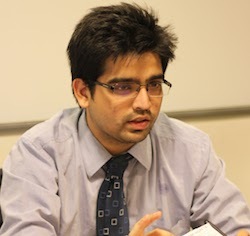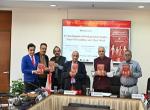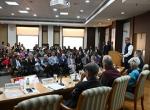The Vivekananda International Foundation (VIF) hosted a delegation from Sichuan University, Chengdu. The delegation consisted of numerous scholars from various backgrounds. The Chinese delegation consisted of the following people:-
- Prof. Yang Wenwu - Deputy Director, Sichuan University
- Zeng Xiangyu, Associate Professor, Institute of South Asian Studies, Sichuan University
- Liu Jiawei, Director, Center for South Asia and West China Development and Cooperation Studies, Sichuan University
- Zhang Chunyan, Associate Professor, College of Foreign Languages and Culture, Sichuan University
- Zou Zengxin, ISAS, Sichuan University
Lt. Gen Sawhney was the moderator of the discussions that took place between VIF and Sichuan University. He expressed the hope that the discussions between the two would help influence policy making and called for more collaborations between the two institutes. He also expressed the hope that more students studying at each other’s universities would help greater people to people exchanges between Asia’s two largest countries. This was followed by presentations by scholars from both the sides.
Bilateral Trade
Prof. Yang Wenwu gave his take on trade between two countries which has not appreciated in recent times due to two reasons, the scale of trade is not as large as it can be and the other being the trade imbalance in favour of China. The reason for the latter is because while China exports high-value-added manufactured goods to India, India exports low-value-added raw materials and primary processed products. According to Prof. Yang Wenwu, the difference in economic structures and the competitive advantage of Chinese trade products in the bilateral trade are reasons behind the trade imbalance.
Prof. Wenwu also claimed that India’s exports to Hong Kong, which make their way to mainland China, is often not seen as part of India’s exports to China, leading to statistical errors. In the short term, Prof. Wenwu called for an expansion of Chinese trade quotas for Indian agricultural and pharmaceutical products and information technology which can help temporarily ease the imbalance between the two countries. Another suggestion was the ‘trade + investment’ approach to balance the trade gap wherein China can make investments in India and then increase exports to China. The final proposal was for strengthening intra-industry cooperation. Adjustment and changes in India’s industrial structure will also help resolve the trade imbalance, he argued.
India-China Historical Maritime Engagement
Chinese speaker argued that there has been maritime connectivity between India and China since the Han Dynasty. The excavation from South India further validates that spices and other commodities were traded through the sea route over centuries. He called for the rejuvenation of maritime tradition in both the countries and joint cooperation in this area.
China, India, and Global Economic Governance Reform
Liu Jiawei argued for enhancing India-China cooperation in reforming the present global governance system. According to him, the problems of the current system includes lack of fairness, problems of enforceability and unilateralism, which undermine the multilateral World Trade Organisation (WTO).
Over the years the European Union (EU), ASEAN and Asia-Pacific Economic Cooperation (APEC) have played important roles in promoting global economic governance and the Group of 20 (G20) is recognised as the forum for discussing international economic cooperation. Liu Jiawei explained the stance of the Chinese in three points:-
- China wants the WTO to retain its core function of regulating a multilateral trading that is non-discriminatory, promotes openness while also ensuring a conducive environment for international trade.
- The reforms should safeguard the interests of developing countries (China sees itself as one) and promote economic integration while adhering to the Sustainable Development Goals of the United Nations 2030 agenda.
- Reforms, Work Agenda and the final result should take place after extensive consultations and in effect, create a consensus based trade and economic organisation.
Chinese view of Indo-US Maritime Security Cooperation
Presentation by Zhang Chunyan was focused on India-U.S cooperation in the Indo–Pacific, the Quadrilateral Security Dialogue and the closeness that has grown between India and the U.S over the last decade. Military vessels of the two countries have docked at each other’s naval ports which, according to her, has led to greater interoperability between the two navies. This has been bolstered by regular military exercises, especially the flagship Malabar exercises.
India-U.S relationship has also helped in dealing with non-traditional security threats such as piracy and in disaster management. According to Zhang there are still differences between the two countries as to what constitutes Indo-Pacific. This is a hindrance for sustaining the Quadrilateral Security Dialogue. According to Zhang, India-China relations need to be revived, especially in the maritime sector.
India-China Maritime Cooperation
Zou Zengxin gave his views on how to take forward India-China relations through Maritime cooperation. Maritime dialogues are an important form of cooperation. In addition, signing of joint statements, high-level government dialogues, academic exchanges and seminars, and maritime policy communication would enhance cooperation. Joint operations between the Indian Navy and PLAN will also be represented. While Maritime security interactions are frequent but cooperation is weak, according to Zou.
Naval modernisation in India has started gaining steam and will balance India’s influence in the Indian Ocean Region (IOR). More dialogues with other countries such as China, would lead to more naval co-operation. Further dialogues according to Zou could also lead to joint research on marine science, maritime technology, and maritime environment. Maritime cooperation according to the Chinese delegation, is hampered by lack of a framework of cooperation as maritime cooperation is susceptible to political tensions.
Maritime cooperation, from the Chinese perspective, includes joint operations for law enforcement, security maintenance in the Indian Ocean, port infrastructure construction, joint maritime defense against terrorism, etc. Policy coordination between China’s Belt Road and Initiative and India’s Make in India initiative and Sagarmala will promote maritime cooperation and also help develop the maritime economy, according to Zou.
India-China Maritime Issues-Non Traditional Security Aspects
Dr. Teshu Singh, Research Fellow, VIF spoke on the Non-Traditional Security issues in the Indian Ocean Region (IOR). The IOR has emerged as the world’s most significant energy and trade seaway and it is important to ensure the safety and security of sea lines of communication. Some of the more urgent issue in non-traditional security in the IOR are Piracy, Maritime Terrorism, Drug Trafficking and Climate Change. India is playing a very active role in dealing with these issues, and it also played a leading role dealing with the after-effects of the Tsunami of 2004. However, the management of non-traditional threats in the IOR raises complex changes as the nature of the threat is often transnational and requires cooperation between the rim and the littorals. India and China can cooperate in advancing the Sustainable Development Goal (SDG) 14 that deals with Life below Water in the Indo-Pacific region, she said.
The Way forward for India and China
Prof. Sujit Dutta, Distinguished Fellow, VIF, in setting the context. talked about the very different ways the two countries think about the world and their place in the world. The Chinese presentations, according to Prof. Dutta, paint a bright picture of things to come for both countries. Their presentations also called for solidarity between India and China, especially in dealing with the global economic systems. This is not easy given the differences in perspectives and interests.
In the initial years after independence, India had campaigned for ‘Asian Solidarity’ in dealing with common problems, as well as for security cooperation and peaceful coexistence. It was dealt a lethal blow by Asian states joining rival blocs in the Cold War and China’s war on India in 1962. India’s thinking has been reoriented by Prime Minister Narendra Modi, who has stressed the need for India, China and the other Asian countries to promote connectivity and creating a new peaceful and rule-based Asian and Indo-Pacific order. India historically has been against hegemonic systems that distort inter-state relations in Asia and undermine peaceful coexistence. The Post-Cold War Indian position has been that it wants balance between the major powers and there should be a multipolar order. It is therefore strengthening ties with all the principal global actors- the U.S, Japan, Russia, France and China.
India-China relations will therefore be shaped not only by bilateral ties but also by their ties with other great powers at a time when deep tensions are rising between some of the major powers: U.S-China, U.S -Russia, E.U-Russia, etc. The U.S-China tensions have an impact on the global trade and global security order. Rapid Chinese military build-up is a result of that competition. Also, the unsettled bilateral security questions and disputes need to be addressed if India-China relations are to be constructive at the global level and cooperative at many levels. Some of these issues need to be resolved as soon as possible in a fair and balanced manner.
Territorial disputes on which negotiations have been going on for 40 years remains unsettled. If territorial disputes are not settled and given Chinese description of core interests which includes large parts of India within China, it is difficult to have a stable diplomatic and security relationship. Therefore, the hope is that the next time President Xi and Prime Minister Modi, meet they would work on ‘early-harvest’ outcomes and resolve at least the central sector of the border.
Another important factor in India-China relations is Pakistan. The Sino-Pak relationship is significantly determined by what China does in and with Pakistan. There is also the question of Chinese policy on the Afghan settlement, as to whether it is going to support the inclusion of the Taliban in a new government and work with Pakistan instead of backing a modernising state system in Afghanistan. Such a course will have destabilising implications given the extremist nature of Taliban. India has observed that the Chinese, Russians and the Americans are somewhat on the same page in their support for Pakistan and the Taliban to come to the table for a solution .India believes this is not going to be stable or workable
Bilateral relations between the two is also dependent on China’s reaction to Pakistan’s state sponsored terrorism, which is focused on India and severely impacts Jammu and Kashmir. Pakistan and China have jointly taken steps against India in raising the Kashmir issue in the UNSC though it was kept informal by the other members. This was most unfortunate at a time when a Modi-Xi summit is being planned.
Conclusion
Dr. Arvind Gupta, Director, VIF concluded the discussion by giving his own insight as to where he sees China going and its impact on India. The effect of the trade issues between U.S and China is no longer restricted to tariffs but is also a struggle for technological dominance. Earlier the principal issue between major powers was military, but now trade and technology have become points of competition.
The world has to deal with China’s rise. While observing how it behaves as it grows, particularly China’s policies in the region its policies towards great powers, neighbours, etc., he said China’s help to Pakistan regarding Kashmir, which was an internal matter of India, by calling a UN Security Council closed door meeting is a setback to India-China relations. There should be efforts to contain the damage that has been done. India-China relations cannot be seen in isolation to such developments.






Post new comment